Research projects at the Chair of Soil Mechanics and Foundation Engineering
Current projects:
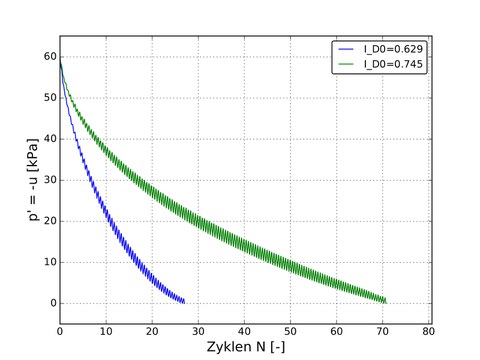
Evolution of pore water pressure in dependence of cyclic loading for a sand with different densities
The soil liquefaction is significantly influenced by the granulometric properties of the soil. The highest tendency regarding liquefaction can be observed for sandy soils. For these soils at full water saturation a compression can take place only by expressing the pore water. Depending on the water permeability an excess pore water pressure can occur which reduces the effective stresses at constant total stresses. If the excess pore water pressure is equal to the effective stress the grain skeleton disintegrates and the soil behaves like a liquid.
As part of this project, the liquefaction tendency of various coarse-grained soils is assessed using a self-developed identification test.
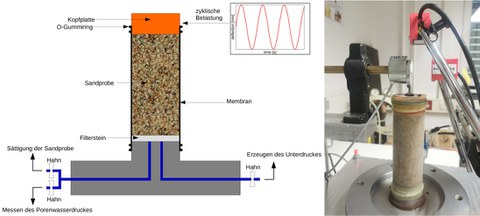
Schematic sketch and image of the experimental setup
For this purpose, a numerical model using an advanced hypoplastic constitutive model is also created.
Funding
DFG
Researcher
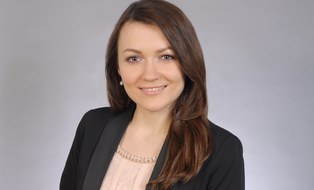
Research Fellow
NameDr.-Ing. Božana Baćić
Research, Course: BIWE-14, BIWO-07, BIW4-62
Send encrypted email via the SecureMail portal (for TUD external users only).
Chair of Soil Mechanics and Foundation Engineering
Visiting address:
Beyer-Bau (BEY), NEU 104 George-Bähr-Str. 1
01069 Dresden
Duration
10/2016 - 04/2024 (1.+2. Phase)
Publications
- B. Baćić und I. Herle, “Density-Dependent Pore Water Pressure Evolution in a Simpli-
fied Cyclic Shear Test,” International Journal of Geosynthetics and Ground Engineering,
Vol. 9, Nr. 4, Juli 2023. DOI: 10.1007/s40891-023-00469-4 . - B. Bacic und I. Herle, “Aufbau des Porenwasserdrucks in Böden mit unterschiedlichen
granulometrischenEigenschaften,” in Ohde-Kolloquium / Geotechnische Herausforde-
rungen: Mehrphasenströmung, Strömung-Boden-Interaktion und Struktur-Boden Wechselwirkungen im Fokus, Bundesanstalt für Wasserbau, Karlsruhe, 2023. - B. Bacic und I. Herle, “A simplified cyclic shear test for pore water pressure evoluti-
on,” in Proceeding of the 17th Danube European Conference on Geotechnical Engineering (17DECGE), 2023. - B. Bacic und I. Herle, “A simplified cyclic shear test for pore water pressure build-
up of different soils,” in Proceeding of the 8th International Symposium on Deformation Characteristics of Geomaterials, ISSMGE, 2023. - Bacic, Bozana; Herle, Ivo: A simple method for the determination of sensitivity to density changes in sand liquefaction . In: Open Geomechanics 2 (2020). DOI: 10.5802/
ogeo.6. - Bacic, Bozana: Laboratory evaluation of liquefaction potential for coarse-grained soils. In: XVII European Conference on Soil Mechanics and Geotechnical Engineering (2019)
- Bacic, Bozana; Herle, Ivo: Identification test for soil liquefaction. In: International Symposium on Deformation Characteristics of Geomaterials (2019)
- Bacic, Bozana; Herle, Ivo: Beurteilung der Verflüssigungsneigung grobkörniger Böden. In: Mitteilungen - Institut für Geotechnik, TU Dresden Heft 24 (2018), S. 115–126
- Schwiteilo, E.; Herle, I.: Index test for liquefaction potential considering the granulometric properties. In: Geomechanics from Micro to Macro 1 (2014), S. 1105–1110
- Herle, Ivo; Schwiteilo, Erik: Bodenverflüssigung als Indexversuch. In: Beiträge zum 2. Kolloquium Bodenverflüssigung bei Kippen des Lausitzer Braunkohlebergbaus (2014), S. 147–158
- Schwiteilo, E.; Herle, I.: Modell- und Elementversuche zur Bodenverflüssigung. In: Mitteilungen des Instituts für Geotechnik / Ohde-Kolloquium 2014, Mitteilungen des Instituts für Geotechnik, TU Dresden 19 (2014), S. 181–192
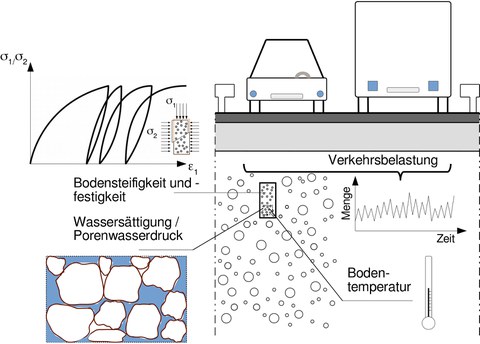
Soil mechanical factors influencing the mechanical behavior of road constructions.
The mechanical behavior of a road construction under traffic load depends on the properties of the subsoil. However, the mechanical properties of the soil and its response are also dependent on the load. Due to this interaction, these two components cannot be divided strictly into loading and resistances. Since soil behavior is highly non-linear and inelastic, the deformations of the subsoil can add up to non-negligible amounts over long periods of time. The accumulation of deformations in the subsoil depends on the cyclic changes in the state variables. These include primarily the effective stresses, which change not only as a result of the traffic load, but also due to fluctuations in the pore water pressure. Other variables that influence subsoil behavior include temperature, water content (degree of saturation) and soil structure. Therefore, soil stiffness and strength are not material parameters, but state-dependent quantities that can only be realistically recorded with the help of material models with a memory. The influence of the relatively low stress level under the road construction on the mechanical soil behavior with cyclic changes in the relevant state variables has hardly been researched. Therefore, this project will investigate and describe the accumulation processes in the subsurface as a result of the interaction with the road construction and other environmental variables. The changing stiffness of the subsoil is to be constantly evaluated in order to initiate local measures in the subsoil in the event of stronger softening (e.g. due to an increase in pore water pressure or volume changes) before the road construction is overloaded. The stiffness is evaluated by means of point measurements in the predefined observation network. As part of the research project, a model stand is being developed in which the load resulting from wheel crossings is simulated and the associated stress, settlement and pore water pressure changes are registered.
Funding
DFG
Researcher
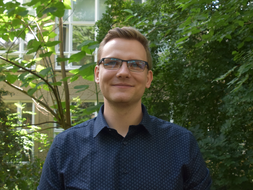 © Institut für Geotechnik
© Institut für Geotechnik
Wissenschaftlicher Mitarbeiter
NameDipl.-Ing. Sebastian Ullmann
Forschung, Modul BIW2-03
Send encrypted email via the SecureMail portal (for TUD external users only).
Chair of Soil Mechanics and Foundation Engineering
Visiting address:
Beyer-Bau (BEY), S 15 George-Bähr-Str. 1
01069 Dresden
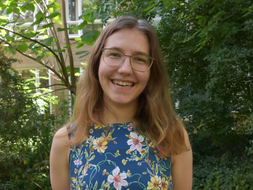 © Institut für Geotechnik
© Institut für Geotechnik
Research assistant
NameDipl.-Ing. Selma Schmidt
Research, Teaching: BIW2-03, BIWE-04
Send encrypted email via the SecureMail portal (for TUD external users only).
Chair of Soil Mechanics and Foundation Engineering
Visiting address:
Beyer-Bau (BEY), S 09 George-Bähr-Str. 1
01069 Dresden
Duration
01/2022-12/2025
Publications
At the Institute of Geotechnical Engineering at Technische Universität Dresden, geotechnical issues related to opencast mine slopes are scientifically supported in cooperation with the Department of Rock and Soil Mechanics at RWE Power AG.
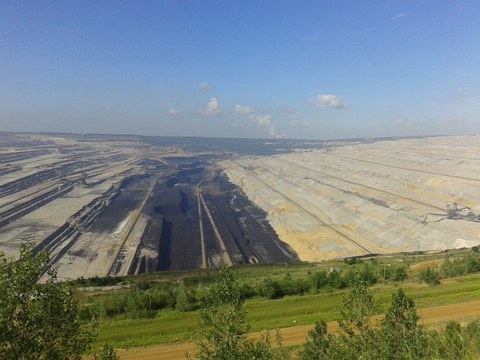
Opencast lignite mining
The implementation of the recommendations of the Commission for "Growth, Structural Change and Employment" by the federal government, leads to the confrontation with numerous new geotechnical questions in the mid-term and long-term perspective. Among other things, mechanical parameters regarding shear strength of the soils in the slopes at the border of the opencast mine are examined with regard to the planned final state. Especially when it comes to questions of stability, a large number of questions arise in relation to the final state of opencast mine slopes. In particular, the creation of opencast mining lakes and the necessary flooding of opencast mines opens up far-reaching questions regarding the investigation of soil properties. In addition to theoretical investigations, laboratory tests are carried out at the IGT to determine soil properties of the opencast mine soils.
Funding
RWE Power AG
Researcher

Research Fellow
NameDr.-Ing. Božana Baćić
Research, Course: BIWE-14, BIWO-07, BIW4-62
Send encrypted email via the SecureMail portal (for TUD external users only).
Chair of Soil Mechanics and Foundation Engineering
Visiting address:
Beyer-Bau (BEY), NEU 104 George-Bähr-Str. 1
01069 Dresden

Research Fellow
NameDr.-Ing. Markus Uhlig
Coordinator Laboratory; Courses: BIW4-10, BIW3-04
Send encrypted email via the SecureMail portal (for TUD external users only).
Chair of Soil Mechanics and Foundation Engineering
Visiting address:
Beyer-Bau (BEY), NEU 104 or in the laboratory George-Bähr-Str. 1
01069 Dresden
Duration
01/2021-06/2025
Publications
When performing and interpreting standard laboratory tests, such as the triaxial test, it is usually assumed that the soil sample is homogeneous during the test. This assumption allows homogenization over the entire sample and the globally measured stress-strain behaviour thus corresponds to the behaviour of the material point.
The assumption of homogeneity is obviously violated as soon as one or more shear zones form in the sample. Various studies have also shown that the sample is already heterogeneous at the beginning of the test and that shear bands can form within the sample, even if they are not globally visible.
In order to be able to consider the heterogeneity of the soil sample when interpreting triaxial tests, it must first be characterized. X-ray computed tomography (CT) is a valuable tool in this regard, as it enables the soil sample to be analyzed at the grain level. In addition, a suitable observation window - a representative elementary volume (REV) - must be selected for the local evaluation of the soil variables, such as the void ratio. The size of the REV can not be too small, as otherwise there will not be a sufficient number of grains within the element, nor too large, as otherwise the heterogeneity of the sample cannot be captured.
The REV is then placed in a regular grid in the sample and thus, the statistical distribution of the soil variables at the initial state of the sample and its evolution throughout the triaxial test is determined. Alternatively, the soil behavior in selected REVs within the sample, e.g. in the forming shear zone, can also be evaluated. In particular, it becomes clear that the soil behaves very differently in different areas of the sample.
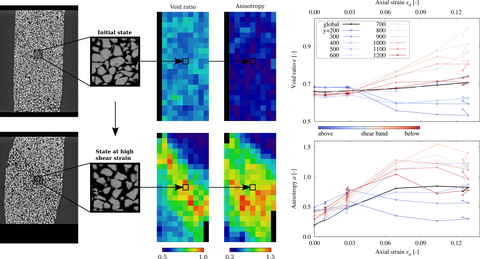
Heterogeneity of a sand specimen at the initial and final state of a triaxial test regarding the void ratio and the anisotropy of the contact orientations as well as the evolution of these variables in different areas of the specimen. Figure modified after Schmidt et al., 2022, Granular Matter
Funding
DFG
Researcher
 © Institut für Geotechnik
© Institut für Geotechnik
Research assistant
NameDipl.-Ing. Selma Schmidt
Research, Teaching: BIW2-03, BIWE-04
Send encrypted email via the SecureMail portal (for TUD external users only).
Chair of Soil Mechanics and Foundation Engineering
Visiting address:
Beyer-Bau (BEY), S 09 George-Bähr-Str. 1
01069 Dresden
Duration
05/2023 - 04/2024
Publications
Schmidt, S., Herle, I., 2024. Heterogeneous and scale-dependent behaviour of an initially dense sand specimen in triaxial compression. Preprint. https://doi.org/10.21203/rs.3.rs-4360008/v1.
Schmidt, S., Wiebicke, M., Herle, I., 2023. Characterisation of the heterogeneity of a sand specimen in triaxial compression using x-ray CT and representative elementary volumes. Proceedings of the 8th International Symposium on Deformation Characteristics of Geomaterials, https://doi.org/10.1051/e3sconf/202454404003.
Schmidt, S., Wiebicke, M., Herle, I., 2022. On the determination and evolution of fabric in representative elementary volumes for a sand specimen in triaxial compression. Granular Matter 24:97, https://doi.org/10.1007/s10035-022-01262-2.
Selection of completed projects after 2010:
Fine-grained soil layers are less permeable and thus, can become a barrier for the groundwater. Below such a barrier various hydraulic boundary conditions can lead to “confined” groundwater This means that the water pressure is higher than it would be for hydrostatic pressure. Since the fine-grained soil layer is not completely impermeable to water, an upwards water flow occurs towards the subsurface. As a result of the hydraulic gradient, soil particles from the fine-grained layer can be rinsed into an overlying coarse-grained layer. The rinsed material causes a locally accelerating water flow with a possible failure of the barrier and the overlying areas. This erosion rupture of a soil layer can also be called “piping”.
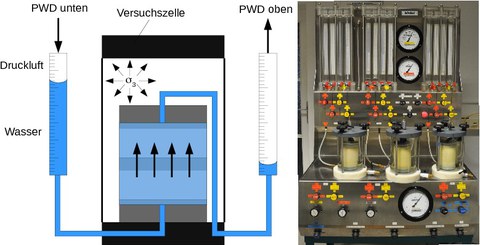
Sketch of the experimental setup for analysing safety against erosion
To test a fine-grained soil regarding safety against erosion rupture, model tests were carried out in a test cell at the Institute of Geotechnical Engineering. For this purpose, an artificial soil structure of filter layer (sand/gravel), sealing layer (distinctly plastic clay) and filter layer (sand/gravel) was flowed through from bottom to top until a failure of the sealing layer occurred. In order to investigate the different influences on erosion safety, the stress state (loading), the loading history (degree of ) and the grain size of the filter material were changed.
The experiments showed that the safety against erosion rupture in the fine-grained layer increases as the filter material becomes finer, the stress state or the degree of over-consolidation of the sealing layer increases.
Funding
Third-party funding by industry partners
Researcher
Dr.-Ing. Johannes Welsch
Duration
09/2016 - 02/2017
Publications
- Welsch, Johannes; Herle, Ivo: Erosion experiments on fine grained soils and their theoretical evaluation. In: 26th European Young Geotechnical Engineers Conference (2018)
- Welsch, Johannes; Herle, Ivo: Anwendung der Dimensionsanalyse zur Untersuchung des Erosionsdurchbruches in feinkörnigen Böden. In: Mitteilungen - Institut für Geotechnik, TU Dresden Heft 24 (2018), S. 83–98
Cooperation between: TPH Bausysteme GmbH, Institute of Hydraulic Engineering and Technical Hydromechanics, TU Dresden and Institute of Geotechnical Engineering, TU Dresden
Many dykes and dams are provided with imperfect sealings for technological and economic reasons. However, water flow can cause processes such as suffosion or contact erosion and thus weaken the earthwork structure. As a result, the hydraulic permeability increases and erosion channels are formed which reduce the stability of the earthwork.
Within the framework of the project and in a practical cooperation project with TPH Bausysteme, an effective sealing method was developed to remedy any defects caused by erosion processes. With the help of an injection method with synthetic material, in dams and dykes a sealing was produced which was equivalent or even of a higher quality with regard to a new building.
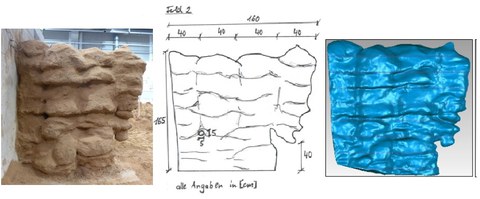
Produced sealing barrier with applied injection method
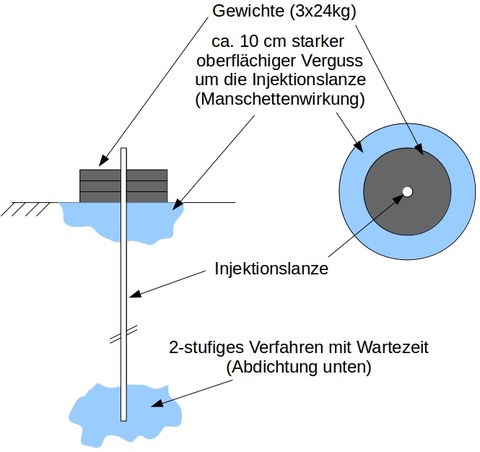
Optimization measure for the production of a continuous sealing barrier
The optimization and modification of the injection technology carried out by means of large-scale tests (height of dam about 2m) in the hydraulic engineering laboratory of the TU Dresden. In the soil mechanical laboratory, the mechanical properties of the injection bodies (uniaxial compressive strength, hydraulic permeability, shear strength) were determined. Further optimization measures allowed the production of a continuous, compact sealing wall, which had a significantly lower hydraulic permeability than the surrounding soil.
Funding
BMWi
Researcher
RNDR. Vladislava Kostkanová PH.D. (ehem. Herbstova)
Silvio Gesellmann
Duration
01/2015 - 10/2016
Publications
In recent years, the usage of gravel or concrete columns has increased to prevent soil liquefaction. However, studies on their operating principles are hardly available. This can be explained by the fact that both numerical calculations with simple constitutive models and small-scale laboratory tests are problematic.
In this project, the application of soil improvement columns as prevention for soil liquefaction was numerically investigated. For this purpose, a hypoplastic constitutive model was used. The analyses focused on the influence of stiffness and permeability of the columns.
Researcher
Dr.-Ing. Jamal Hleibieh
Duration
04/2012 - 04/2016
Publications
- Hleibieh, Jamal: Prevention of soil liquefaction using stone columns. In: 25 th European Young Geotechnical Engineers Conference (2016)
- Herle, I.; Hleibieh, J.: Prevention of soil liquefaction using stone or concrete columns. In: Beitrag in XV Danube - European Conference on Geotechnical Engineering (DECGE 2014) 1 (2014), S. 291–296
- Hleibieh, J.: Bodenverbesserungssäulen als Prävention der Bodenverflüssigung bei Erdbebenbeanspruchung. In: Workshop - Bemessen mit numerischen Methoden. TU Hambrug-Harburg, Grabe, J. (Herausgeber), 123-137, (2013), S. 123–137
In practice, the very complex mechanical soil behaviour is usually described only by an approach with simple constitutive models. The most frequently used is the linear-elastic, ideal-plastic material model with the boundary condition according to Mohr-Coulomb. The used model parameters E, ν, φ, c 'and ψ are regarded as invariables and independent of the soil state. However, describing soil behaviour by this simplified approach may not reflect objectively and reliably its characteristics.
The concept of Critical State Soil Mechanics (CSSM) allows a reliable and efficient determination of shear parameters. The determined parameters can be comprehended relatively easily and checked for plausibility. In theory, all state-independent parameters such as φc (critical friction angle) or Cc and Cs (compression or threshold value) are determined in the laboratory. The state-dependent parameters are derived from the above-mentioned parameters.
In the project, a systematic approach was developed that enables a routine application of the CSSM theory in industry Thus, the reliability and validity of the evaluation of laboratory experiments increases.
In the further course, the soil state (i.e. stress state, density) is included in the consideration. The soil behaviour is described and assessed in comparison to defined reference states. The evaluation should be as redundant and comprehensible as possible. This includes also an analysis of the occurring errors in the evaluation.
Funding
Third-party funding by industry partners
Researcher
Dr.-Ing. Erik Schwiteilo (ehem. Nacke)
Duration
02/2011 - 12/2015
Publications
- Schwiteilo, Erik; Herle, Ivo: Bewertung von Scherversuchen aus Vergleichsuntersuchungen an feinkörnigem Boden. In: Mitteilungen - Institut für Geotechnik, TU Dresden Heft 24 (2018), S. 1–15
- Schwiteilo, Erik: Bestimmung bodenmechanischer Parameter nach fortgeschrittenen Methoden. Dresden, Technische Universität, Dissertation, 2017
- Schwiteilo, Erik; Herle, Ivo: Plausibilitätsbewertung von Laborversuchen zur Bestimmung von Scherkennwerten. In: BAW-Mitteilung (2016), S. 67–78
- Schwiteilo, E.: Uncertainties in reference states in the determination and validation of soil parameters. In: Proceedings of the 24 th European Young Geotechnical Engineers Conferenc (2015)
- Schwiteilo, E.: Konzept für die Auswertung und Herleitung von Bodenkennwerten. In: Tagungsband Baugrundtagung 2014/ Forum Junge Geotechniker (2014), S. 37–44
The possibilities for evaluating cone penetration tests (CPT) are diverse. However, many evaluation approaches require an empirical factor, e.g. for the evaluation of the undrained shear strength.
In this project, the results of cone penetration tests were compared with results from laboratory experiments regarding the undrained shear strength. Therefore, drilling cores with undisturbed material were taken and examined in the laboratory of the Institute of Geotechnical Engineering. The aim was to narrow down the empirical factor of undrained shear strength in order to perform more reliable interpretations. At the same time, the determination of soil types by means of CPTs was verified.
For coarse-grained soils, results of cone penetration tests can be evaluated by means of the spherical cavity expansion using advanced constitutive models. In order to assess the consistency of the soil in situ, the calibration factors which are necessary for the spherical cavity expansion must be determined by laboratory tests and numerical simulations. Therefore, small-scale cone penetration tests with a miniature CPT-probe were numerically recalculated using the spherical cavity expansion. The penetration of the miniature CPT-probe into the soil sample was simulated with an FE-model and compared to the computation results of the spherical cavity expansion. The FE-model has been created in ABAQUS. Furthermore, the role of the surface friction of the CPT-probe was considered in the evaluation. For this purpose, the friction behaviour between the metal and the soil was experimentally investigated and simulated by means of a hypoplastic interface model.
Funding
Third-party funding by industry partners
Researcher
Dr.-Ing. Markus Uhlig
Duration
07/2010 - 06/2012 & 09/2014 - 12/2015
Publications
- Uhlig, Markus; Herle, Ivo: Auswertung von Drucksondierungen in Kippenböden. In: BAW-Mitteilung (2016), S. 129–141
- Uhlig, M.; Herle, I.: Bestimmung der Porenzahl aus Drucksondierungen. In: 2. Deutsche Bodenmechanik-Tagung 2015 (2015), S. 85–100
- Uhlig, M.; Herle, I.: Advanced analysis of cone penetration tests. In: XVI European Conference on Soil Mechanics and Geotechnical Engineering (2015)
- Uhlig, M.: Advanced analyses of cone penetration test in fine-grained soils. In: Proceedings of EYGEC 2014, Barcelona (2014), S. 41–44
- Herle, I.; Uhlig, M.: Experimentelle und numerische Untersuchungen zur Drucksondierung in feinkörnigen Böden. In: 4. Fachtagung Geotechnik, HTW Dresden (2013), Nr. 04, S. 11–20
Observations and measurements in the laboratory and in-situ show that soil deformations occur even with constant static equilibrium and unchanged loading conditions. This is also observed in large slopes of open-pit mines. Here, after the mining activity is finished displacements decrease significantly but do not cease completely. The deformation behaviour represents a state of equilibrium and should be clarified for the assessment of slope stability because simultaneous physical mechanisms may be responsible.
Within the framework of the project, the relevant physical phenomena which can lead to deformations were summarized and evaluated. The following phenomena were considered in detail:
-
dissipation of pore water pressures
-
volumetric and deviatoric creep
-
cyclic loading
-
progressive failure
Furthermore, for the description of the physical phenomena different mathematical models (constitutive models) were presented and the used material parameters were introduced. Using FE-simulations, for predicting time-dependent soil deformations the results of the application of the constitutive models were shown and evaluated. Subsequently, the characteristic stress paths of the FE-simulations were simulated with the aid of load-controlled triaxial tests and the measured deformations were evaluated. The laboratory tests were numerically simulated using different constitutive models and the calculated and measured deformations were compared.
Funding
Third-party funding by industry partners
Researcher
Dipl.-Ing. Georg Lichtblau
Duration
02/2010 - 09/2014
Publications
- Nitzsche, Kornelia; Herle, Ivo: Wiedererkennung von Verschiebungsmustern in Aushubböschungen. In: 1. Fachsektionstagung (2017), S. 406–411
- Nitzsche, Kornelia: Verschiebungsmuster in Böschungen während Aushubvorgängen. Dresden, Technische Universität, Dissertation, 2016
- Nitzsche, K.; Herle, I.: Analysis of displacement patterns during an excavation using different constitutive models. In: Numerical Methods in Geotechnical Engineering II (2014), S. 777–782
- Nitzsche, K.; Herle, I.: Vergleich von gemessenen und numerisch nachgerechneten Verformungen bei spannungspfadgesteuerten Triaxialversuchen. In: BAW Mitteilungen (2012), Nr. 95, S. 80–91
- Herle, I.; Nitzsche, K.: Prognose von aushubbedingten Baugrundverformungen. In: 16. Dresdner Baustatik-Seminar (2012)
- Nitzsche, Kornelia; Herle, Ivo: Numerical analysis of displacements with different constitutive models. In: Proceedings of the 21st European Young Geotechnical Engineers Conference (2011), S. 291–297
For economic reasons, instead of conventional static test loads more and more dynamic test loads are being carried out on concrete columns. With dynamic test loads, satisfactory experiences have been gained when the concrete columns were embedded in sands or gravels. In this case, the results of the dynamic test loads were comparable to those of the static ones.
The aim of the project was to investigate whether or in which cases dynamic load tests give similarly good results in clayey or silty soils. For this purpose, static and dynamic load tests were numerically modelled using the finite element method. In order to depict realistically the soil behaviour, a hypoplastic constitutive model was used. The material parameters were calibrated by means of a geotechnical report and former research work.
On the basis of a parameter study, the scope of application for static and dynamic test loads was examined and recommendations were made.
Funding
Keller Holding GmbH
Researcher
Dr.-Ing. Max Wiebicke
Duration
05/2013 - 06/2014
Complex geotechnical construction projects are subject to great risks due to uncertainties in the ground survey and the subsoil model. Designing engineers and construction companies counteract the risks by maintaining high safety margins in the design draft and by constant supervision of the construction work. In the context of the observation method, the standard calls for the adaptation of the subsoil model and construction method to the observed soil behaviour. A requirement that cannot be met satisfactorily yet.
In advance of the start of construction, a realistic prediction of the soil behaviour is difficult because of the aforementioned complexity. During the construction, however, by monitoring the soil behaviour a forecast model can be continuously improved based on the measurement results. Such an approach enables gradually the limitation of the uncertainties associated with the subsoil and to adapt accordingly construction methods and building design. This leads to a higher safety of the construction project while reducing construction costs. The outlined approach - also known as the observation method - currently fails due to the great expenses. The high amount of work involved in system identification, starting with the evaluation of the measuring sensors, setting up the non-linear constitutive models, non-linear calculation, iterative remodelling and recalculation, renders a prompt system diagnostics and an adaptation of the production process difficult. Within the frame of the project, a knowledge-based software system was developed, which enables a consistent, computer-aided application of the observational method in construction practice.
An adaptive production process for geotechnical engineering was a further aim. By means of a web platform a flexible, needs-based integration of knowledge- and databases, web services with simulation and analysis algorithms, computing resources and consulting services has resulted in a monitoring and control system with extremely short response times. The core of the system are logical and algorithmic software components that enable a prompt knowledge and simulation-based system identification within the framework of a new, continuous, coupled construction and monitoring process.
Funding
BMBF - KMU Innovativ
Researcher
Dipl.-Ing. M. Kupka
Duration
07/2010 - 06/2013
Publications
- Kupka, M.; Herle, I.: Stoffgesetz-, Parameter- und Systemidentifikation innerhalb des GeoTechControl-Systems. In: Veranstaltungen des Instituts für Bauinformatik - Heft 5 (2013), S. 93–99
- Kupka, Michael; Herle, Ivo: Baugrundverhalten und seine Abbildung in Materialmodellen. In: Fachkonferenz Bauinformatik - Baupraxis 2011, Veranstaltungen des Instituts für Bauinformatik (2011), Nr. 5, S. 99–106
Further information
The first project phase dealt with the classification of different fine-grained soils. For selected soil samples the mechanical properties were investigated by carrying out laboratory tests to investigate the shear and compression behaviour. Based on the test results, the parameters for a hypoplastic constitutive model were calibrated. This was followed by FE-calculations to determine the temporal development of the undrained shear strengths.
In a second project phase, cone penetration tests (CPTs) at different time intervals were carried out in a defined study area. The CPTs were evaluated with respect to the undrained shear strength. For the evaluation different approaches were used. At the same time, undisturbed soil samples were taken and in the laboratory also analysed regarding the undrained shear strengths. The results of the CPTs were compared with the laboratory results. Furthermore, a comparison of the temporal development of shear strengths by means of FE-calculations was conducted.
Funding
Third-party funding by industry partners
Researcher
Prof. Dr.-Ing. habil. I.Herle
Mgr. V. Kostkanová Ph.D.
Dipl.-Ing. K. Nitzsche
Dipl.-Ing. M.Uhlig
S. Gesellmann
Duration
01/2009 - 12/2015
Publications
- Uhlig, Markus; Herle, Ivo: Prognoseverfahren zur Bestimmung der zeitabhängigen undrainierten Scherfestigkeit von Tagebaukippen. In: XVI Danube - European Conference on Geotechnical Engineering (2018)
- Uhlig, Markus; Herle, Ivo: Bestimmung der zeitlich veränderlichen undrainierten Scherfestigkeit in feinkörnigen Kippenböden. In: 1. Fachsektionstagung (2017), S. 394–399
- Uhlig, Markus; Herle, Ivo: Stability of Slopes in Open Pit Mines. In: The 8th China International Forum on Work Safety (2016)
- Uhlig, Markus; Herle, Ivo; Karcher, Christian: Determination of time-dependent undrained shear strength of mining landfill. In: 1.ICEGT (2016)
- Herle, I.; Masin, D.; Kostkanova, V.; Karcher, Ch.; Dahmen, D.: Experimental investigation and theoretical modelling of soft soils from mining deposits. In: International Symposium on Deformation Characteristics of Geomaterials, September 1-3, 2011, Seoul, Korea (2011), S. 858–864
- HERLE, I.; MAŠÍN, D.; KOSTKANOVÁ, V.; DAHMEN, D.; KARCHER, C.:
Experimentelle Untersuchung und theoretische Betrachtung von weichen Kippenmischböden. IN: Vorträge der Baugrundtagung 2010 in München, DGGT, 2010, 65-70 - HERLE, I.; HERBSTOVÁ, V.; MAŠÍN, D.; KARCHER, C.:
Physikalische und mechanische Eigenschaften von weichen Kippenböden - Experimente und Theorie. In: 4. Symposium Umwelttechnik & 5. Freiberger Geotechnik-Kolloquium & Fachaustellung, 2009, 460-465.
Damages to adjacent structures or other piles have often been observed while fabricating full displacement drill piles. In order to avoid damages, the mechanical behaviour of the surrounding soil, as well as its displacements during the installation process, were investigated. In the process, significant influencing parameters were identified. For the analysis, numerical investigations were carried out using advanced hypoplastic constitutive models. The numerical model was verified with a large-scale test.
Funding
DAAD
Researcher
Dr.-Ing. M. Arnold
Dr.-Ing. Markus Uhlig
Dr.-Ing. Erik Schwiteilo (ehem. Nacke)
Duration
01/2011 - 12/2012
Publications
- Larisch, M.; Nacke, E.: Simulation of Auger Displacement Pile Installation. In: 11th Australia - New Zealand Conference on Geomechanics (2012)
- Larisch, M. D.; Arnold, M.; Uhlig, M.; Schwiteilo, E.; Williams, D. J.; Scheuermann, A.: Stress and displacement monitoring of auger displacement piles. In: Proceedings of Pile 2013 (2013)
Within the framework of the project, experimental results of mechanical laboratory tests, carried out in different soil mechanical laboratories in Germany, were compared and analysed. In order to test a material which is homogeneous and comparable, clayey soil samples were prepared and preconsolidated. To each participating laboratory, the handling of the sample material and the performance of the laboratory tests were reported in a detailed description of the individual testing steps. The derived soil characteristics from the laboratory results spread in a relatively wide range. Analysing the laboratory results their scattering can be mainly reduced to the testing conditions.
Researcher
Dr.-Ing. Erik Schwiteilo (ehem. Nacke)
Publications
- Schwiteilo, Erik; Herle, Ivo: Comparative study on the compressibility and shear parameters of a clayey soil. In: China-Europe Conference on Geotechnical Engineering 2018 (2018)
- Schwiteilo, Erik; Herle, Ivo: Bewertung von Scherversuchen aus Vergleichsuntersuchungen an feinkörnigem Boden. In: Mitteilungen - Institut für Geotechnik, TU Dresden Heft 24 (2018), S. 1–15
- Schwiteilo, Erik; Herle, Ivo: Vergleichsstudie zur Kompressibilität und zu den Scherparametern von Ton aus Ödometer- und Rahmenscherversuchen. In: Geotechnik 40 (2017), Nr. 3, S. 204–217
Within the frame of the GreenHeat3 project, it is currently being investigated how and where the construction of a large multi-functional heat storage with solar energy can be carried out in the greater Dresden area. In particular with the help of solar energy, water is to be heated in a storage tank which can be fed into the district heating system.
In the first project stage, a feasibility study was carried out. Therefore, investigations on possible solar thermal collector field variants and basic investigations on the type and size of the multi-functional heat storage were conducted. In addition, landscape planning aspects and specifications had to be clarified and included in the process of planning.
Among the project partners are DREWAG - Stadtwerke Dresden GmbH, CWH Ingenieurgesellschaft mbH as well as the Institute of Power Engineering, Institute of Landscape Architecture, Institute of Construction Management and Institute of Geotechnical Engineering of the Technische Universität Dresden.
The Institute of Geotechnical Engineering has taken soil samples in the planning area. In the laboratory, the soil samples were classified and mechanical tests were carried out to analyse the compression and shear behaviour. In addition, laboratory tests to determine the thermal conductivity and heat capacity were conducted. Furthermore, numerical settlement calculations were realized to estimate the displacements in the bottom and flanks of the storage basin. Moreover, for the flanks of the storage basin stability calculations were realized. The results obtained from the investigations on the thermal conductivity are currently used in a numerical model to simulate the heat propagation in the surrounding soil of the reservoir.
Funding
BMWi
Researcher
Dipl.-Ing. Georg Lichtblau
Dr.-Ing. Erik Schwiteilo (ehem. Nacke)
Duration
01/2017 - 12/2018
The sealing of dikes and dams is an essential basis for their functionality. A reliable sealing prevents excessive leakage and thus an erosion-induced failure of the earthwork structure.
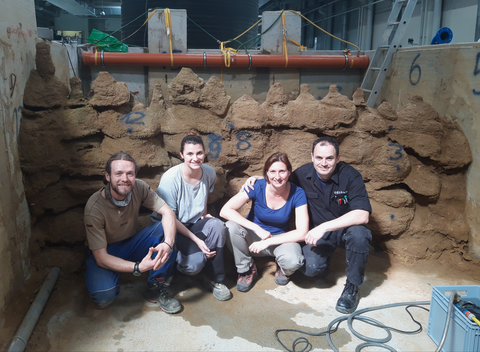
Extracted injection wall (sealing between structure and earthwork) - Field test 2. From left to right: Dirk Fleischer (IWD), Rebecca Thiesen (Diplomandin IGT), Vladislava Kostkanova (IGT), Silvio Gesellmann (IGT)
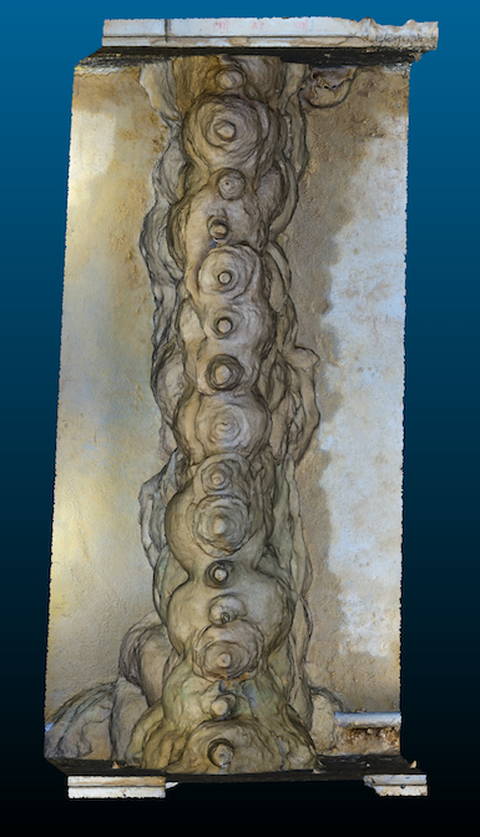
Photogrammatic illustration of the injection wall (top view). Used software: Photoscan (Inst. of Photogrammetry and Remote Sensing).
The use of acrylate gels for the production of sealing bodies is well suited for subsequent interior sealing and for sealing leakages and connection points between earthwork structures and solid structures. However, a performance control and a quality proof of the injection are currently not possible by means of non-destructive testing. Within the framework of the project, practicable detection technologies based on geophysical methods for acrylate gel injections will be developed and tested together with TPH Bausysteme, Geophysik & Geotechnik Leipzig and the Institute of Hydraulic Engineering and Technical Hydromechanics of the TU Dresden. This technology shall allow the detection of existing weak spots or unsuccessfully injected areas in order to realize a targeted post-injection.
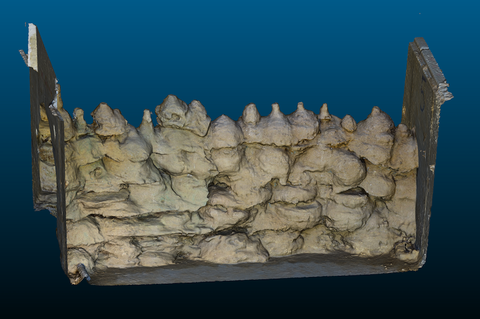
Photogrammatic illustration of the injection wall (front view). Used software: Photoscan (Inst. of Photogrammetry and Remote Sensing).
Initially, a sensitivity study will be carried out on composite samples prepared under laboratory conditions in order to verify the basic applicability of various geophysical methods. In addition, the detectability of the used injection medium will, as far as possible, be adjusted. This will be followed by injection trials in a large-scale test stand at the Institute of Hydraulic Engineering and Technical Hydromechanics with the aim of designing and testing the detection technology. The geophysical parameters determined on the composite samples and injection bodies are compared and discussed with geotechnical parameters (including density, water content, permeability, axial compressive strength).
Funding
BMWi
Researcher
RNDR Vladislava Kostkanova PH. D. (ehem. Herbstova)
Silvio Gesellmann
In order to describe the behaviour of soils, in geomechanics a wide variety of fabric models of varying complexity has been developed. Fabric models which are able to map phenomena of granular materials resort to so-called state variables. These state variables allow depicting special phenomena such as anisotropy or deformation history. However, the state variables have mostly emerged from theoretical concepts and have not yet been demonstrated experimentally. Therefore, their understanding is purely conceptual and not physical.
In recent years, there has been a rapid development of new experimental methods to characterize the entire deformation field of soil samples, i.e. to track the movements of individual grains. For example, this can be realized by stopping the loading process of a soil sample during an experiment at selected times. While interrupting the loading process, the sample is scanned by an X-ray tomograph. To derive various aspects from these tomographic images, methods have been developed which are capable of characterizing the micromechanical behaviour in certain load and deformation states. Thus, images of the position of the individual grains to each other are taken.
The project focuses primarily on the soil behaviour during small strains. An international collaboration with the Laboratoire 3SR in Grenoble enables the performance of a series of different experiments in the X-ray computer tomograph. In particular, the experiments analyse the soil behaviour at load reversal and cyclic loading. The evaluation of experiments is mainly concerned with the evolution of the structure of the grain skeleton.
Furthermore, at the Institute of Geotechnical Engineering of TU Dresden series of laboratory tests are carried to calibrate the parameters of the constitutive model to be used and to investigate the influence of the state variables by means of macroscopic observations. Subsequently, both testing procedures are evaluated and correlated.
The aim of the project is to capture the micromechanical behaviour by means of a mathematical formulation and to refer to macroscopic observations. Further on, a connection to the phenomenological approaches of the constitutive models is to be established. This will allow to address and to explain physically the concepts of the state variables of the constitutive models.
Funding
DFG
Researcher
Dr.-Ing. Max Wiebicke
Duration
01/2014 - 12/2020
Publications
- Wiebicke, Max; Andò, Edward; Viggiani, Gioacchino; Herle, Ivo: Zur Strukturentwicklung granularer Materialien in Scherversuchen. In: Mitteilungen - Institut für Geotechnik, TU Dresden Heft 24 (2018), S. 49–66
- Wiebicke, Max; Smilauer, Václav; Herle, Ivo; Andò, Edward; Viggiani, Gioacchino: Validation of Synthetic Images for Contact Fabric Generated by DEM. In: China-Europe Conference on Geotechnical Engineering 2018 (2018)
- Wiebicke, Max; Andò, Edward; Viggiani, Gioacchino; Herle, Ivo: On the measurement of fabric evolution in granular materials with x-ray tomography. In: Annual Report #2, Grenoble Geomechanics Group Laboratoire 3SR (2017)
- Wiebicke, Max; Andò, Edward; Salvatore, Erminio; Viggiani, Gioacchino; Herle, Ivo: Experimental measurement of granular fabric and its evolution under shearing. In: Powders and Grains 2017 – 8th International Conference on Micromechanics on Granular Media (2017)
- Wiebicke, Max; Andò, Edward; Herle, Ivo; Viggiani, Gioacchino: On the metrology of interparticle contacts in sand from x-ray tomography images. In: Measurement Science and Technology 28 (2017)
- Wiebicke, Max; Andò, Edward; Viggiani, Gioacchino; Herle, Ivo: Optische Bestimmung der Struktur von Granulaten. In: BAW-Mitteilung (2016), S. 59–65
- Wiebicke, M.; Ando, E.; Viggiani, G.; Herle, I.: Towards the measurement of fabric in granular materials with x-ray tomography. In: Sixth International Symposium on Deformation Characteristics of Geomaterials (2015)
- Ando, E.; Tengattini, A.; Wiebicke, M.; Viggiani, G.; Salager, S.; Desrues, J.: Multi-resolution characterisation of grain-based measurements from x-ray tomography. In: 2nd International Conference on Tomography of Materials and Structures (2015)
- Wiebicke, M.; Viggiani, G.; Andò, E.; Caillerie, E.: Experimentelle Ermittlung intergranularer Kräfte unter Nutzung von 2D-DIC. In: Mitteilungen des Instituts für Geotechnik / Ohde-Kolloquium 2014, Mitteilungen des Instituts für Geotechnik, TU Dresden 19 (2014), S. 27–43
The construction materials used in the field of geotechnical engineering are mostly natural soils whose properties such as compressibility or strength can vary widely. For the design of structures, i.e. the dimensioning of single components or the deformation calculations of a structure, the knowledge about soil properties are essential. Soil properties are usually determined by standardized testing procedures in a geotechnical laboratory.
However, in geotechnical practice it has been shown that even with testing procedures and evaluations that correspond to the standards differences in the determined mechanical characteristics can occur between various geotechnical laboratories.
The focus of the project is an international comparison of test methods and the scientific approach in determining the compressibility and shear strength of soils. For this purpose, homogenised and thus comparable soil samples shall be examined in accordance with the relevant standard.
The following investigations are planned:
- Determination of the compressibility with oedometric compression tests
- Determination of the shear strength with direct shear tests
Based on investigations in the own country, an international comparison of determined soil characteristics and investigation procedures is aimed whereas differences shall be underlined. In order to get to know testing methods and investigation procedures, the respective exchange scientists will carry out experiments themselves and analyse the usual procedure on-site. The first exchange took place with Moscow State University of Civil Engineering. The aim was to develop a recommendation for the determination of different soil properties.
Funding
DAAD, DFG (GreatIPID4all)
Researcher
Dr.-Ing. Erik Schwiteilo (ehem. Nacke)
Dr.-Ing. Johannes Welsch
Duration
03/2018-
Selection of completed projects before 2010:
In practice, the stability of slopes is increasingly assessed with the method of finite elements. Here, the method of phi/c-reduction is mainly used. However, it has been insufficiently studied yet. Within the framework of the project, the sensitivity and reliability of the phi/c-reduction were analysed and compared with the results of conventional methods. For the FE-calculations the software programmes TOCHNOG and PLAXIS were used. Furthermore, the applicability of advanced constitutive models to this method was assessed.
Funding
DFG
Researcher
Dipl.-Ing. M. Kupka
Duration
11/2006 - 10/2009
Publications
-
KUPKA, M.; HERLE, I.; ARNOLD, M.:
Advanced calculations of safety factors for slope stability. International Journal of Geotechnical Engineering, 2009, 3(4), 509-515, doi:10.3328/IJGE.2009.03.04.509-515 -
KUPKA, M.:
Standsicherheitsberechnungen von Böschungen mit der φ/c-Reduktion.
In: OHDE-Kolloquium 2009, Institut für Geotechnik, TU Dresden, Mitteilungen, Heft 16, 2009, S. 101-117 -
KUPKA, M.; HERLE, I.; ARNOLD, M.:
Advanced calculations of safety factors for slope stability.
In: D. N. Singh (ed.): Proc. 12th International Conference of International Association for Computer Methods and Advances in Geomechanics (IACMAG), Goa, India, 1-6 October 2008, 4470-4477 -
KUPKA, M.:
Standsicherheitsberechnung von Böschungen mit der φ,c-Reduktion.
In: 30. Baugrundtagung, Dortmund, Forum für junge Geotechnik-Ingenieure, Deutsche Gesellschaft für Geotechnik, 2008, Seiten 13-15
Soils are best compacted by repeated shearing. The strain amplitude plays an important role in the maximum attainable compaction. Experimental studies confirm the influence of a simultaneous, multi-directional shearing on the velocity and the size of the compaction.
Within the framework of the project, two different methods of vibro-displacement compaction were examined in the light of these findings. Strain paths were determined in elastic FE-calculations. A stiffness, which depends on the strain amplitude, was also considered. For this purpose, several FE-calculations were carried out. Depending on the distance to the vibrator, the stiffness was determined by the shearing amplitude of the previous run. Subsequently, the strain paths obtained with the FEM were used to carry out single element tests with a hypoplastic constitutive model including intergranular strains.
The compaction profiles show three characteristic areas: compaction near the vibrator, maximum compaction area and non-compacted area at a greater distance from the vibrator. Especially in the more remote areas, vibro-displacement compaction by means of deep vibrators resulted in faster compaction than vibro-displacement compaction by means of stack vibrators. The reason is suspected in the more general multiaxial shearing of the deep vibrator.
Funding
Keller Holding GmbH
Researcher
Dr. M. Arnold
Duration
04/2007 - 03/2008
Publications
-
ARNOLD, M.; HERLE, I.:
Comparison of Vibrocompaction Methods by Numerical Simulations.
International Journal for Numerical and Analytical Methods in Geomechanics, 2009, 33(16), 1823-1838, doi:10.1002/nag.798 -
ARNOLD, M.; HERLE, I.:
Numerical modelling of vibrocompaction.
In: Proc. 11th Baltic Sea Geotechnical Conference, Gdansk, Poland, 15-18 September 2008, 675-682 -
ARNOLD, M.; HERLE, I.; WEHR, J.:
Comparison of vibrocompaction methods by numerical simulations.
In: M. Karstunen; M. Leoni (eds.): Geotechnics of Soft Soils - Focus on Ground Improvement, Proc. 2nd International Workshop on Geotechnics of Soft Soils, University of Strathclyde, Glasgow, Scotland, 3-5 September 2008, 3-11
Hypoplastic material models are increasingly used for the calculation of geotechnical problems. Simple hypoplastic models are capable to depict different soil behaviour characteristics, e.g. the non-linearity of the tangential stiffness under isotropic and deviatoric loading or the stress and density dependence of stiffness and strength. By introducing an elastic region in hypoplastic models, the reproduction of increased stiffness at small strains can be improved. In addition, these advanced constitutive models are also suitable for non-monotonic stress and strain paths.
The mentioned properties of the mechanical soil behaviour are also observed in contacts between soil and structures. Therefore, it is worth using hypoplastic models for the description of the mechanical behaviour of soil-structure contacts. Within the framework of the project, contact models were developed which are based on hypoplastic constitutive models. These contact models allow the usage of the same parameters for the soil and the contact surface. With two further parameters, the contact model can be adapted to the mobilized shear stresses with displacement as well as to the maximum shear stress ratio of the contact. The two remaining parameters are determinable from contact shear tests or with the help of the literature.
Researcher
Dr.-Ing. M. Arnold
Publications
-
ARNOLD, M.:
Application of the Intergranular strain concept to the hypoplastic modelling of non-adhesive interfaces.
In: D. N. Singh (ed.): Proc. 12th International Conference of International Association for Computer Methods and Advances in Geomechanics (IACMAG), Goa, India, 1-6 October 2008, 747-754 -
ARNOLD, M.; HERLE, I.:
Hypoplastic description of the frictional behaviour of contacts.
In: H. Schweiger (ed.): Numerical methods in geotechnical engineering, Taylor & Francis, 2006, 101-106 -
ARNOLD, M.:
Hypoplastische Beschreibung zweidimensionaler Reibungskontakte.
In: OHDE-Kolloquium, Institut für Geotechnik, TU Dresden, Mitteilungen, Heft 15, 2005, S. 69-86 -
ARNOLD, M.:
Zur Berechnung des Erd- und Auflastdrucks auf Winkelstützwände im Gebrauchszustand
Institut für Geotechnik, TU Dresden, Mitteilungen, Heft 13, 2004
The development of earth pressure was measured weekly in four vertical sections with four measuring points each on the outer basement walls of the central lecture hall at the TU Dresden. Thus, a realistic approach of earth pressure for the dimensioning of outer basement walls was obtained. The results were taken into account in the revision of DIN 4085.
Researcher
Dr.-Ing. M. Arnold S. Gesellmann
Duration
06/1998 - 06/2008
Publications
-
ARNOLD, M.:
Erddruck auf Kellerwände - eine stark schwankende Größe? In: 28. Baugrundtagung, Leipzig, Forum für junge Geotechnik-Ingenieure, Deutsche Gesellschaft für Geotechnik, 2004, Seiten 10-11 -
FRANKE, D.; ARNOLD, M.; BARTL, U. & VOGT, L.:
Erddruckmessungen an der Kelleraußenwand eines mehrgeschossigen Massivbaus, Bauingenieur, 78(3), 2003, Seiten 125-130
Floods are one of the main risks of cultural heritage. The interdisciplinary European CHEF-(Cultural Heritage Protection Against Flooding)-project was launched to evaluate damage potential to movable and immovable cultural assets and to identify damage reduction -/damage mitigation strategies and repair options.
The aim was to provide guidelines for flood events to the authorities. Within the framework of the project, the Institute of Geotechnical Engineering analysed the effects of flooding on the construction ground.
Funding
EU FP 7
Researcher Mgr. V. Herbstová Dipl.-Ing. M. Kupka
Duration
04/2007 - 04/2010
Publications
- HERLE, I.; HERBSTOVÁ, V.; KUPKA, M.; KOLYMBAS, D.:
Geotechnical Problems of Cultural Heritage due to Floods.
Journal of Performance of Facilities, 2010, Vol. 24, 446-451. doi:10.1061/(ASCE)CF.1943-5509.0000058


